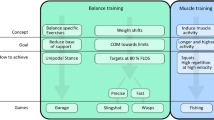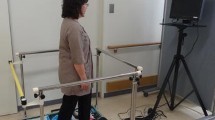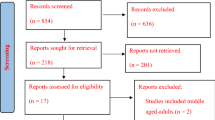Abstract
This study aimed to analyze the effects of exergaming and resistance training on reaction time in older adults and to investigate intraindividual variability in reaction time. Thirty-six participants (62.1 ± 7.1 years), randomly assigned to exergaming (n = 17) or resistance training (n = 19) groups, underwent two protocols of physical training carried out three times a week for 13 weeks. The exergaming program was based on games from Kinect Sports and Kinect Adventures collections using a console Xbox 360 Kinect. In the resistance-training program, each session consisted of ten full-body exercises using free weights and weight machines. Outcomes were reaction time in simple (finger-press test) and complex (Stroop test) tasks and intraindividual variability. A mixed model analysis of variance was conducted, and effects sizes were calculated. Interactions effects revealed no significant differences between groups before and after 13 weeks of training. Regarding the main effects, only the exergaming group showed a significant (p = 0.041) and relevant decrease in reaction time in a complex task (neutral test) when compared to the pre- (1854 ± 732 ms) and post-tests (1530 ± 521 ms). The resistance-training group showed a trend (relevant effect size) of improvement in intraindividual variability in reaction time. These results suggest that both interventions could benefit the cognitive function of older adults. Exergaming improves the reaction time in a complex task, and resistance training improves the intraindividual variability. However, exergaming was not superior to resistance training in any of the outcomes. Trial Registration: Brazilian Clinical Trials Registry (RBR-7fh22d/) on 06/07/2019, retrospectively registered.


Similar content being viewed by others
References
Ainslie, P. N., Cotter, J. D., George, K. P., Lucas, S., Murrell, C., Shave, R., Thomas, K. N., Williams, M. J. A., & Atkinson, G. (2008). Elevation in cerebral blood flow velocity with aerobic fitness throughout healthy human ageing. The Journal of Physiology, 586(16), 4005–4010. https://doi.org/10.1113/jphysiol.2008.158279
Anders, P., Lehmann, T., Müller, H., Grønvik, K. B., Skjæret-Maroni, N., Baumeister, J., & Vereijken, B. (2018). Exergames inherently contain cognitive elements as indicated by cortical processing. Frontiers in Behavioral Neuroscience, 12, 102. https://doi.org/10.3389/fnbeh.2018.00102
Ashor, A. W., Lara, J., Siervo, M., Celis-Morales, C., Oggioni, C., Jakovljevic, D. G., & Mathers, J. C. (2015). Exercise modalities and endothelial function: A systematic review and dose–response meta-analysis of randomized controlled trials. Sports Medicine, 45(2), 279–296. https://doi.org/10.1007/s40279-014-0272-9
Asteasu, M. L. S., Martinez-Velilla, N., Zambom-Ferraresi, F., Casas-Herrero, A., & Izquierdo, M. (2017). Role of physical exercise on cognitive function in healthy older adults: A systematic review of randomized clinical trials. Ageing Research Reviews, 37, 117–134. https://doi.org/10.1016/j.arr.2017.05.007
Bakar, Y., Tuğral, A., Özel, A., & Altuntaş, Y. D. (2020). Comparison of a 12-week whole-body exergaming program on young adults: Differentiation in flexibility, muscle strength, reaction time, and walking speed between sexes. Clinical Nursing Research, 29(7), 424–432. https://doi.org/10.1177/1054773818797881
Bauermeister, S., & Bunce, D. (2016). Aerobic fitness and intraindividual reaction time variability in middle and old age. Journals of Gerontology Series b: Psychological Sciences and Social Sciences, 71(3), 431–438. https://doi.org/10.1093/geronb/gbu152
Bielak, A. A., & Brydges, C. R. (2019). Can intraindividual variability in cognitive speed be reduced by physical exercise? Results from the LIFE Study. Journals of Gerontology Series b: Psychological Sciences and Social Sciences, 74(8), 1335–1344. https://doi.org/10.1093/geronb/gby101
Blondell, S. J., Hammersley-Mather, R., & Veerman, J. L. (2014). Does physical activity prevent cognitive decline and dementia?: A systematic review and meta-analysis of longitudinal studies. BMC Public Health, 14(1), 1–12. https://doi.org/10.1186/1471-2458-14-510
Borg, G. (1982). Ratings of perceived exertion and heart rates during short-term cycle exercise and their use in a new cycling strength test. International Journal of Sports Medicine, 3(03), 153–158. https://doi.org/10.1055/s-2008-1026080
Brydges, C. R., Carlson, M. C., Andrews, R. M., Rebok, G. W., Bielak, A. A. M. (April 2021). Using cognitive intraindividual variability to measure intervention effectiveness: results from the Baltimore experience corps trial. The Journals of Gerontology: Series B, 76(4), 661–670. https://doi.org/10.1093/geronb/gbaa009
Buuren, S. V., & Groothuis-Oudshoorn, K. (2010). mice: Multivariate imputation by chained equations in R. Journal of Statistical Software, 1–68.
Cepeda, N. J., Blackwell, K. A., & Munakata, Y. (2013). Speed isn’t everything: Complex processing speed measures mask individual differences and developmental changes in executive control. Developmental Science, 16(2), 269–286. https://doi.org/10.1111/desc.12024
Coetsee, C., & Terblanche, E. (2017). The effect of three different exercise training modalities on cognitive and physical function in a healthy older population. European Review of Aging and Physical Activity, 14(1), 1–10. https://doi.org/10.1186/s11556-017-0183-5
Cohen, J. (1988). Statistical power analysis for the behavioral sciences. Lawrence Earlbaum Associates.
Cooper, L. L., Woodard, T., Sigurdsson, S., van Buchem, M. A., Torjesen, A. A., Inker, L. A., Aspelund, T., Eiriksdottir, G., Harris, T. B., Gudnason, V., Launer, L. J., & Mitchell, G. F. (2016). Cerebrovascular damage mediates relations between aortic stiffness and memory. Hypertension, 67(1), 176–182. https://doi.org/10.1161/HYPERTENSIONAHA.115.06398
Era, P., Sainio, P., Koskinen, S., Ohlgren, J., Härkänen, T., & Aromaa, A. (2011). Psychomotor speed in a random sample of 7979 subjects aged 30 years and over. Aging Clinical and Experimental Research, 23(2), 135–144. https://doi.org/10.1007/BF03351077
Fragala, M. S., Beyer, K. S., Jajtner, A. R., Townsend, J. R., Pruna, G. J., Boone, C. H., Bohner, J. D., Fukuda, D. H., Stout, J. R., & Hoffman, J. R. (2014). Resistance exercise may improve spatial awareness and visual reaction in older adults. The Journal of Strength & Conditioning Research, 28(8), 2079–2087. https://doi.org/10.1519/JSC.0000000000000520
Guimarães, A. V., Barbosa, A. R., & Meneghini, V. (2018). Active videogame-based physical activity vs. aerobic exercise and cognitive performance in older adults: A randomized controlled trial. Journal of Physical Education and Sport, 18(1), 203–209. https://doi.org/10.7752/jpes.2018.01026
Halliday, D. W., Gawryluk, J. R., Garcia-Barrera, M. A., MacDonald, S. W., & for The Alzheimer’s Disease Neuroimaging Initiative,. (2019). White matter integrity is associated with intraindividual variability in neuropsychological test performance in healthy older adults. Frontiers in Human Neuroscience, 13, 352. https://doi.org/10.3389/fnhum.2019.00352
Hardy, C. J., & Rejeski, W. J. (1989). Not what, but how one feels: The measurement of affect during exercise. Journal of Sport and Exercise Psychology, 11(3), 304–317. https://doi.org/10.1123/jsep.11.3.304
Herold, F., Törpel, A., Schega, L., & Müller, N. G. (2019). Functional and/or structural brain changes in response to resistance exercises and resistance training lead to cognitive improvements – A systematic review. European Review of Aging and Physical Activity, 16(1), 1–33. https://doi.org/10.1186/s11556-019-0217-2
Iuliano, E., di Cagno, A., Aquino, G., Fiorilli, G., Mignogna, P., Calcagno, G., & Di Costanzo, A. (2015). Effects of different types of physical activity on the cognitive functions and attention in older people: A randomized controlled study. Experimental Gerontology, 70, 105–110. https://doi.org/10.1016/j.exger.2015.07.008
Kerchner, G. A., Racine, C. A., Hale, S., Wilheim, R., Laluz, V., Miller, B. L., & Kramer, J. H. (2012). Cognitive processing speed in older adults: Relationship with white matter integrity. PLoS ONE, 7(11), e50425. https://doi.org/10.1371/journal.pone.0050425
Kimura, K., Obuchi, S., Arai, T., Nagasawa, H., Shiba, Y., Watanabe, S., & Kojima, M. (2010). The influence of short-term strength training on health-related quality of life and executive cognitive function. Journal of Physiological Anthropology, 29(3), 95–101. https://doi.org/10.2114/jpa2.29.95
Liao, Y. Y., Chen, I. H., Hsu, W. C., Tseng, H. Y., & Wang, R. Y. (2021). Effect of exergaming versus combined exercise on cognitive function and brain activation in frail older adults: A randomised controlled trial. Annals of Physical and Rehabilitation Medicine, 64(5), 101492. https://doi.org/10.1016/j.rehab.2021.101492
Lieberman, D. A., Chamberlin, B., Medina, E., Jr., Franklin, B. A., Sanner, B. M., & Vafiadis, D. K. (2011). The power of play: Innovations in Getting Active Summit 2011: A science panel proceedings report from the American Heart Association. Circulation, 123(21), 2507–2516. https://doi.org/10.1161/CIR.0b013e318219661d
Liu-Ambrose, T., Nagamatsu, L. S., Graf, P., Beattie, B. L., Ashe, M. C., & Handy, T. C. (2010). Resistance training and executive functions: A 12-month randomized controlled trial. Archives of Internal Medicine, 170(2), 170–178. https://doi.org/10.1001/archinternmed.2009.494
Lu, K., Nicholas, J. M., James, S. N., Lane, C. A., Parker, T. D., Keshavan, A., Keuss, S. E., Buchanan, S. M., Murray-Smith, H., Cash, D. M., Sudre, C. H., Malone, I. B., Coath, W., Wong, A., Henley, S. M. D., Fox, N. C., Richards, M., Schott, J. M., & Crutch, S. J. (2020). Increased variability in reaction time is associated with amyloid beta pathology at age 70. Alzheimer’s & Dementia: Diagnosis, Assessment & Disease Monitoring, 12(1), e12076. https://doi.org/10.1002/dad2.12076
MacDonald, S. W., Nyberg, L., & Bäckman, L. (2006). Intra-individual variability in behavior: Links to brain structure, neurotransmission and neuronal activity. Trends in Neurosciences, 29(8), 474–480. https://doi.org/10.1016/j.tins.2006.06.011
Maillot, P., Perrot, A., & Hartley, A. (2012). Effects of interactive physical-activity video-game training on physical and cognitive function in older adults. Psychology and Aging, 27(3), 589. https://doi.org/10.1037/a0026268
Meneghini, V., Barbosa, A. R., de Mello, A. L. S. F., Bonetti, A., & Guimarães, A. V. (2016). Perception of the elderly regarding participation in exergaming-based exercise: A qualitative study. Ciência & Saúde Coletiva, 21(4), 1033–1041. https://doi.org/10.1590/1413-81232015214.11812015
Nelson, M. E., Rejeski, W. J., Blair, S. N., Duncan, P. W., Judge, J. O., King, A. C., Macera, C. A., Castaneda-Sceppa, C., American College of Sports Medicine, & American Heart Association. (2007). Physical activity and public health in older adults: Recommendation from the American College of Sports Medicine and the American Heart Association. Circulation, 116(9), 1094–1105. https://doi.org/10.1161/CIRCULATIONAHA.107.185650
Pachana, N. A., Thompson, L. W., Marcopulos, B. A., & Yoash-Gantz, R. (2004). California older adult Stroop test (COAST) development of a Stroop test adapted for geriatric populations. Clinical Gerontologist, 27(3), 3–22. https://doi.org/10.1300/J018v27n03_02
Rubin, D. B. (2004). Multiple imputation for nonresponse in surveys (Vol. 81). John Wiley & Sons.
Salthouse, T. A. (2000). Aging and measures of processing speed. Biological Psychology, 54(1–3), 35–54. https://doi.org/10.1016/S0301-0511(00)00052-1
Stroop, J. R. (1935). Studies of interference in serial verbal reactions. Journal of Experimental Psychology, 18(6), 643. https://doi.org/10.1037/h0054651
United Nations. (2017). World population prospects: The 2017 revision. United Nations.
van Ginkel, J. R., & Kroonenberg, P. M. (2014). Analysis of variance of multiply imputed data. Multivariate Behavioral Research, 49(1), 78–91. https://doi.org/10.1080/00273171.2013.855890
van Ginkel, J. R. (2014). SPSS syntax for applying rules for combining multivariate estimates in multiple imputation. Leiden University. Retrieved from http://www.socialsciences.leiden.edu/educationandchildstudies/childandfamilystudies/organisation/staffcfs/van-ginkel.html
Villafaina, S., Collado-Mateo, D., Fuentes, J. P., Rohlfs-Domínguez, P., & Gusi, N. (2019). Effects of exergames on brain dynamics in women with fibromyalgia: A randomized controlled trial. Journal of Clinical Medicine, 8(7), 1015. https://doi.org/10.3390/jcm8071015
Wu, S., Jo, E. A., Ji, H., Kim, K. H., Park, J. J., Kim, B. H., & Cho, K. I. (2019). Exergaming improves executive functions in patients with metabolic syndrome: Randomized controlled trial. JMIR Serious Games, 7(3), e13575. https://doi.org/10.2196/13575
Acknowledgements
The authors would like to thank all participants for engaging in this study.
Funding
This study was financed in part by the Coordenação de Aperfeiçoamento de Pessoal de Nível Superior—Brasil (CAPES)—Finance Code 001. The funding source was not involved in the conduction of the research neither in the preparation of the article.
Author information
Authors and Affiliations
Contributions
Vandrize Meneghini: Conceptualization, Methodology, Formal analysis, Investigation, Writing – Review & Editing. Aline Rodrigues Barbosa: Conceptualization, Methodology, Writing – Review & Editing, Supervision, Project Administration. Camilo Luis Monteiro Lourenço: Methodology, Investigation, Writing – Review & Editing. Adriano Ferreti Borgatto: Formal analysis, Writing – Review & Editing.
Corresponding author
Ethics declarations
Conflicts of Interest/Competing Interests
The authors declare no conflict of interest.
Informed Consent
None.
Ethical Treatment of Experimental Subjects (Animal and Human)
No experimental treatment was conducted on either human or animal subjects in this study.
Ethics Approval
The study was approved by the Universidade Federal de Santa Catarina Ethical Committee, nº 64415516.8.0000.0121, on 25/05/2017. The procedures used in this study adhere to the tenets of the Declaration of Helsinki.
Consent to Participate
All participants provided written consent prior to the study.
Consent for publication
Not applicable.
Additional information
Publisher's Note
Springer Nature remains neutral with regard to jurisdictional claims in published maps and institutional affiliations.
Supplementary Information
Below is the link to the electronic supplementary material.
Supplementary file3 (DOCX 16 KB)
Supplementary file4 (DOCX 16 KB)
Rights and permissions
About this article
Cite this article
Meneghini, V., Barbosa, A.R., Lourenço, C.L.M. et al. Effects of Exergaming and Resistance Training on Reaction time and Intraindividual Variability in Older Adults: a Randomized Clinical Trial. Ageing Int 48, 547–562 (2023). https://doi.org/10.1007/s12126-022-09491-9
Accepted:
Published:
Issue Date:
DOI: https://doi.org/10.1007/s12126-022-09491-9




